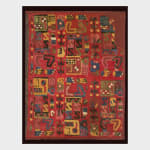Huari Culture 100 AD-1200 AD
21 x 23 in
The iconography on this textile segment is unique as testimony to the virtuosity of Andean artists' skills and creative accomplishments. It depict rows of staff-bearing figures, wherein the figures reverse direction in each row or from one column to the next. While they retain a few general elements of classic Huari (Wari) iconography, they differ in several features. These distinctions include the form of the plant-like staffs held by the figures, the square and diagonally colored teeth of the figures, the nose line form, the quartered eyes with alternating colors, the backward-facing feet, the treatment of the thumb on the hands holding the staffs, the alternation of the figures' direction within the panel, and the backward S/Z motifs on the figures' tunics, among other aspects.
Structurally, patterning by allover supplemental wefts on a ground is not observed in Wari textiles. The original warp lengths cannot be determined from what remains of the original panels; however, the original loom width is evident on both panels at 23 inches. This loom width is not characteristic of Wari tapestry tunics.
Join our mailing list
* denotes required fields
We will process the personal data you have supplied in accordance with our privacy policy (available on request). You can unsubscribe or change your preferences at any time by clicking the link in our emails.



